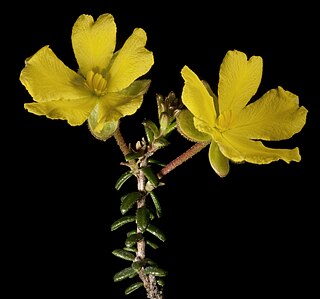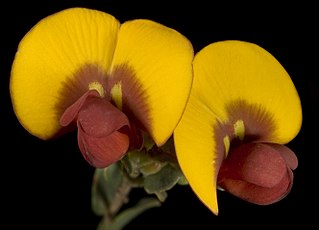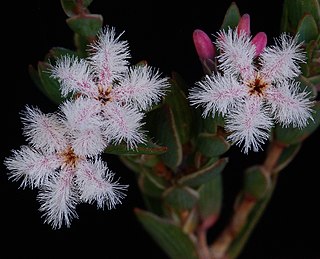
Hibbertia amplexicaulis is a species of flowering plant in the family Dilleniaceae and is endemic to Western Australia. It is a prostrate, sprawling, straggling or ascending shrub that typically grows to a height of 0.1–0.6 m, rarely as tall as 1 m. It blooms between August and March producing yellow flowers. It was first formally described in 1845 by Ernst Gottlieb von Steudel in Lehmann's Plantae Preissianae. The specific epithet (amplexicaulis) means "stem-clasping", referring to the leaves.

Hibbertia commutata is a species of flowering plant in the family Dilleniaceae and is endemic to the south-west of Western Australia. It is a low, erect, many-branched shrub with narrow elliptic to narrow egg-shaped leaves, and yellow flowers with fifteen to thirty stamens arranged around three carpels.

Hibbertia subvaginata is a species of flowering plant in the family Dilleniaceae and is endemic to Western Australia. It is a small shrub that has yellow flowers with stamens arranged around three or four carpels.
Hibbertia cactifolia is a species of flowering plant in the family Dilleniaceae and is endemic to the Arnhem Land escarpment. It is a multi-stemmed shrublet with hairy foliage, oblong to elliptic leaves and yellow flowers arranged singly in leaf axils, with twenty-six to twenty-eight stamens arranged in groups around the two carpels.
Hibbertia circularis is a species of flowering plant in the family Dilleniaceae and is endemic to the northern part of the Northern Territory. It is a perennial herb with prostrate, trailing branches, elliptic to more or less round leaves, and yellow flowers arranged in leaf axils, with thirty stamens arranged in groups around the two carpels.
Hibbertia depilipes is a species of flowering plant in the family Dilleniaceae and is endemic to the far south-west of Western Australia. It is usually a sprawling shrub with scattered linear leaves and yellow flowers arranged singly in leaf axils usually with ten stamens all on one side of the two carpels.

Hibbertia desmophylla is a species of flowering plant in the family Dilleniaceae and is endemic to the south-west of Western Australia. It is a sprawling or erect, hairy shrub with spreading, densely clustered, linear leaves and yellow flowers with eleven to thirteen stamens.
Hibbertia helianthemoides is a species of flowering plant in the family Dilleniaceae and is endemic to a small area in the south-west of Western Australia. It is a prostrate to low-lying, spreading to erect, hairy shrub with hairy foliage, linear leaves and yellow flowers with thirteen stamens.

Hibbertia hemignosta is a species of flowering plant in the family Dilleniaceae and is endemic to the south-west of Western Australia. It is a prostrate to erect shrub that typically grows to a height of 30–50 cm (12–20 in). It was first formally described in 1845 by Ernst Gottlieb von Steudel who gave it the name Pleurandra hemignosta in Lehmann's Plantae Preissianae. In 2002, Judy Wheeler changed the name to Hibbertia hemignosta in Journal of the Adelaide Botanic Gardens. The specific epithet (hemignosta) means "half-known", but the reason for that name was not given. This hibbertia grows on sandplains, flats and slopes in the Avon Wheatbelt, Coolgardie, Esperance Plains, Jarrah Forest, Mallee, Swan Coastal Plain and Warren biogeographic regions in the south-west of Western Australia.

Hibbertia hibbertioides is a species of flowering plant in the family Dilleniaceae and is endemic to near-coastal areas of south-western Western Australia. It is a small, prostrate or sprawling shrub with crowded, linear cylindrical leaves and yellow flowers with usually eleven stamens arranged in groups around three carpels.

Hibbertia huegelii is a species of flowering plant in the family Dilleniaceae and is endemic to the south-west of Western Australia. It is an erect, spreading or prostrate shrub with hairy branchlets, linear leaves and yellow flowers arranged singly in leaf axils on the ends of shoots, with fifteen to twenty-five stamens in bundles around the four or five carpels.

Hibbertia lineata is a species of flowering plant in the family Dilleniaceae and is endemic to the south-west of Western Australia. It is a spreading to erect shrub with linear to narrow egg-shaped leaves and yellow flowers, usually with ten stamens arranged on one side of, and leaning over the two densely hairy carpels.
Hibbertia lividula is a species of flowering plant in the family Dilleniaceae and is endemic to the south-west of Western Australia. It is an erect or sprawling shrub with thin branchlets, bluish-grey, narrow elliptic to narrow oblong leaves and yellow flowers, with thirty to forty stamens arranged around the five glabrous carpels.

Hibbertia microphylla is a species of flowering plant in the family Dilleniaceae and is endemic to the south-west of Western Australia. It is a shrub with weakly ascending stems, broadly egg-shaped to elliptic leaves and yellow flowers, usually with ten stamens and up to nine staminodes arranged on one side of, and leaning over the two densely hairy carpels.

Bossiaea pulchella is a species of flowering plant in the family Fabaceae and is endemic to the south-west of Western Australia. It is a slender, erect shrub with egg-shaped leaves, and orange-yellow, purplish brown and dark red flowers.
Hibbertia pulchra is a species of flowering plant in the family Dilleniaceae and is endemic to the south-west of Western Australia. It is a multi-stemmed shrub with clustered, linear to narrow egg-shaped leaves with the narrower end towards the base, and yellow flowers with eleven stamens arranged around three carpels.
Bossiaea spinescens is a species of flowering plant in the family Fabaceae and is endemic to the south-west of Western Australia. It is a slender, spreading or compact, spiny shrub with oblong to oval leaves and yellow and reddish-brown, pea-like flowers.

Hibbertia striata is a species of flowering plant in the family Dilleniaceae and is endemic to the southwest of Western Australia. It is a spreading shrub with linear leaves and yellow flowers usually with thirty stamens arranged in five bundles around five glabrous carpels.

Hibbertia montana is a species of flowering plant in the family Dilleniaceae and is endemic to the south-west of Western Australia. It is an erect, straggling or sprawling shrub with densely hairy foliage, narrow oblong leaves, and pedunculate yellow flowers with thirty to sixty stamens and a few staminodes arranged around velvety carpels.

Leucopogon elegans is a species of flowering plant in the heath family Ericaceae and is endemic to the south-west of Western Australia. It is a spreading shrub with egg-shaped leaves, and white or pink, tube-shaped flowers densely bearded on the inside.














